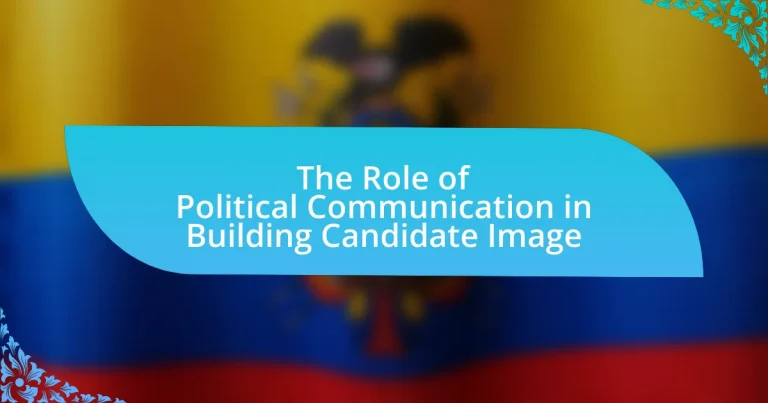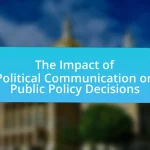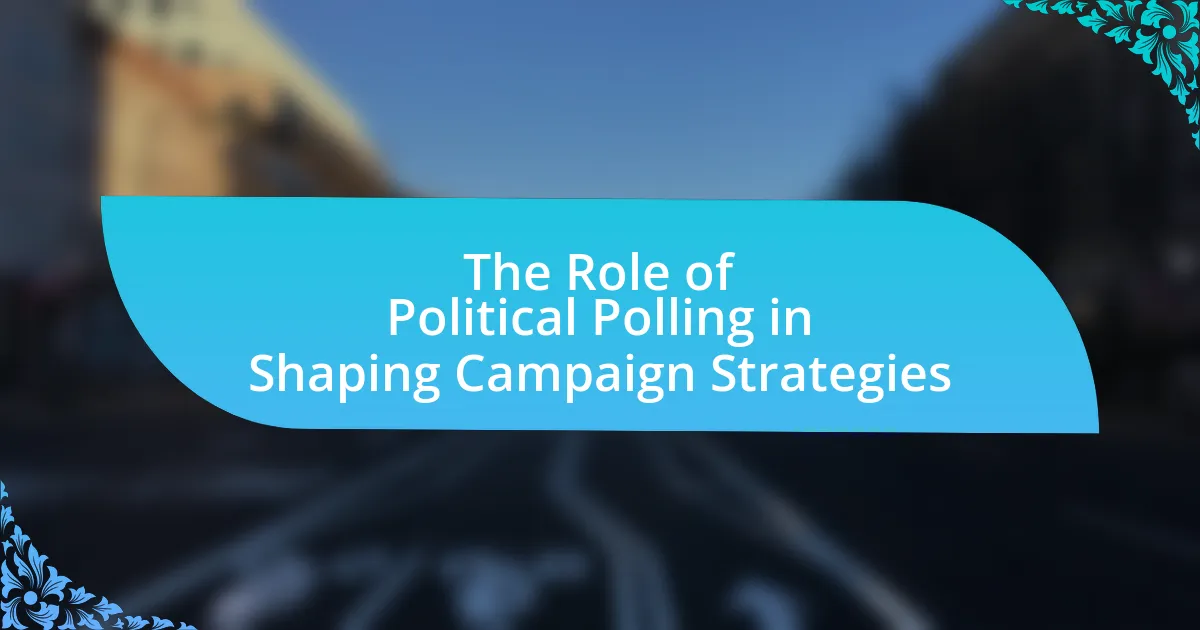The article examines the critical role of political communication in shaping a candidate’s image, emphasizing how strategic messaging influences public perception and voter behavior. It outlines key elements such as messaging, media strategy, public engagement, and image management that contribute to a candidate’s public persona. The discussion includes the impact of social media, the significance of endorsements, and the challenges candidates face in maintaining a positive image amidst misinformation. Additionally, it highlights best practices for effective communication, including targeted messaging and active engagement with constituents, to enhance voter trust and support.
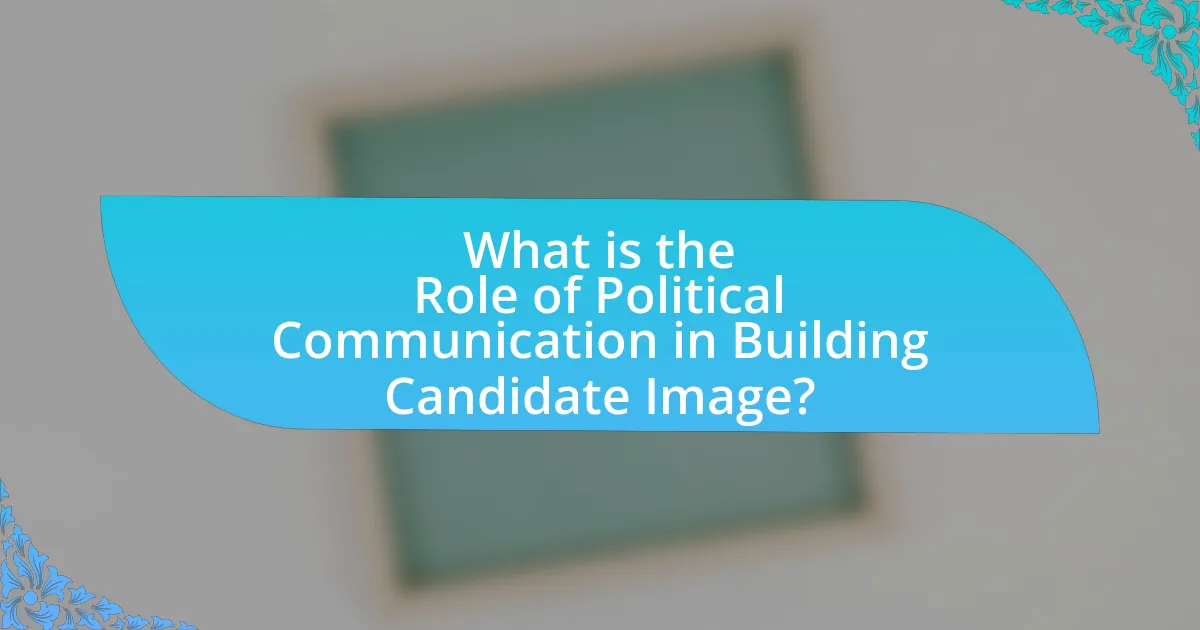
What is the Role of Political Communication in Building Candidate Image?
Political communication plays a crucial role in building a candidate’s image by shaping public perception and influencing voter attitudes. Through strategic messaging, candidates can highlight their values, policies, and personal narratives, which helps to create a distinct identity in the minds of voters. For instance, during the 2008 U.S. presidential election, Barack Obama’s campaign effectively utilized social media and targeted messaging to craft a compelling image of hope and change, significantly impacting voter engagement and support. This demonstrates that effective political communication not only conveys information but also fosters emotional connections, ultimately shaping how candidates are viewed by the electorate.
How does political communication influence public perception of candidates?
Political communication significantly influences public perception of candidates by shaping narratives and framing issues that resonate with voters. Through strategic messaging, candidates can highlight their strengths, address weaknesses, and connect emotionally with the electorate. For instance, studies show that candidates who effectively utilize social media platforms can enhance their visibility and relatability, leading to increased support. Research by the Pew Research Center indicates that 69% of adults in the U.S. use social media, making it a critical tool for candidates to engage with the public and influence opinions. Additionally, the framing of political issues in media coverage can sway public perception; candidates portrayed positively in news stories tend to receive higher approval ratings. Thus, the methods and channels of political communication are vital in constructing and altering the public’s image of candidates.
What are the key elements of political communication that shape candidate image?
The key elements of political communication that shape candidate image include messaging, media strategy, public engagement, and image management. Messaging involves the core themes and narratives that candidates promote to resonate with voters, such as policy positions and personal values. Media strategy encompasses the selection of platforms and formats for communication, including social media, television, and debates, which significantly influence public perception. Public engagement refers to direct interactions with constituents through town halls, rallies, and forums, allowing candidates to build rapport and trust. Image management involves the careful crafting and maintenance of a candidate’s public persona, often through branding techniques and crisis communication strategies. These elements collectively determine how candidates are perceived by the electorate, impacting their overall electoral success.
How do media channels affect the dissemination of candidate images?
Media channels significantly influence the dissemination of candidate images by shaping public perception and controlling the narrative surrounding candidates. Different media platforms, such as television, social media, and print, have distinct characteristics that affect how candidate images are presented and received. For instance, social media allows for rapid sharing and interaction, enabling candidates to engage directly with voters, which can enhance their image through personal connection. Conversely, traditional media often provides a more curated and less interactive portrayal, which can either bolster or undermine a candidate’s image based on editorial choices. Research indicates that candidates who effectively utilize diverse media channels can create a more favorable public image, as evidenced by the 2008 Obama campaign, which leveraged social media to engage younger voters and shape a positive candidate narrative.
Why is candidate image important in political campaigns?
Candidate image is crucial in political campaigns because it shapes public perception and influences voter behavior. A positive candidate image can enhance trust and relatability, making voters more likely to support the candidate. Research indicates that candidates with favorable images tend to receive higher levels of voter engagement and support; for instance, a study by the Pew Research Center found that 70% of voters consider a candidate’s personality and image when making their voting decisions. This underscores the importance of effective political communication strategies in crafting and maintaining a strong candidate image throughout the campaign.
What impact does a strong candidate image have on voter behavior?
A strong candidate image significantly influences voter behavior by enhancing perceived trustworthiness and relatability. Research indicates that candidates who project a positive image are more likely to attract voter support; for instance, a study published in the Journal of Politics found that candidates with favorable public images received up to 20% more votes than those with negative perceptions. This effect is attributed to voters’ tendency to favor candidates they perceive as competent and likable, which can lead to increased voter turnout and engagement.
How does candidate image correlate with election outcomes?
Candidate image significantly correlates with election outcomes, as a positive public perception can enhance voter support and increase the likelihood of winning. Research indicates that candidates who project a strong, relatable image tend to attract more voters; for instance, a study by the Pew Research Center found that 70% of voters consider a candidate’s personality and image as important factors in their decision-making process. Furthermore, candidates with favorable images often benefit from increased media coverage and social media engagement, which can amplify their reach and influence. This correlation is evident in various elections, where candidates with well-crafted images, such as Barack Obama in 2008, successfully leveraged their public persona to secure electoral victories.
What strategies are used in political communication to build candidate image?
Political communication employs several strategies to build a candidate’s image, including targeted messaging, media engagement, and personal branding. Targeted messaging involves crafting specific narratives that resonate with key voter demographics, ensuring that the candidate’s values align with the audience’s concerns. Media engagement encompasses utilizing various platforms, such as social media and traditional news outlets, to amplify the candidate’s message and create a favorable public perception. Personal branding focuses on establishing a distinct identity for the candidate, often through storytelling and visual imagery, which helps voters connect emotionally. These strategies are supported by research indicating that effective political communication can significantly influence voter perceptions and electoral outcomes.
How do candidates utilize social media for image building?
Candidates utilize social media for image building by actively engaging with voters, sharing their policies, and showcasing their personalities. This engagement allows candidates to create a relatable and approachable image, which is crucial in modern political campaigns. For instance, a study by the Pew Research Center found that 69% of adults in the U.S. use social media, making it an effective platform for candidates to reach a broad audience. By posting regular updates, responding to comments, and participating in trending conversations, candidates can enhance their visibility and foster a sense of community among supporters. Additionally, targeted advertising on platforms like Facebook and Instagram enables candidates to tailor their messages to specific demographics, further solidifying their image in the minds of potential voters.
What role do debates and public appearances play in shaping candidate image?
Debates and public appearances are crucial in shaping a candidate’s image by providing a platform for direct engagement with voters and showcasing their policies and personality. These events allow candidates to demonstrate their communication skills, respond to questions, and differentiate themselves from opponents, which can significantly influence public perception. For instance, a study by the Pew Research Center found that candidates who perform well in debates often see a boost in their poll numbers, indicating that effective communication can enhance their appeal. Additionally, public appearances help candidates build rapport with constituents, reinforcing their relatability and trustworthiness, which are essential factors in voter decision-making.
How do political communication tactics evolve during a campaign?
Political communication tactics evolve during a campaign by adapting to changing voter sentiments, technological advancements, and strategic objectives. Initially, campaigns often focus on broad messaging to establish a candidate’s identity and key issues. As the campaign progresses, tactics shift towards targeted communication, utilizing data analytics to identify and engage specific voter demographics. For instance, the 2008 Obama campaign effectively used social media platforms to mobilize younger voters, demonstrating a shift from traditional media to digital engagement. This evolution is further evidenced by the increasing use of micro-targeting and personalized messaging, which became prominent in the 2016 election cycle, allowing campaigns to tailor their outreach based on individual voter preferences and behaviors.
What challenges do candidates face in maintaining a positive image?
Candidates face significant challenges in maintaining a positive image due to the pervasive influence of social media and the rapid spread of misinformation. Social media platforms can amplify negative narratives and create echo chambers that distort public perception, making it difficult for candidates to control their image. Additionally, the constant scrutiny from the media and opponents can lead to misinterpretations of candidates’ statements or actions, further complicating their efforts to present a favorable image. Research indicates that 70% of voters report being influenced by negative campaign ads, highlighting the impact of adversarial communication on candidates’ public perception.
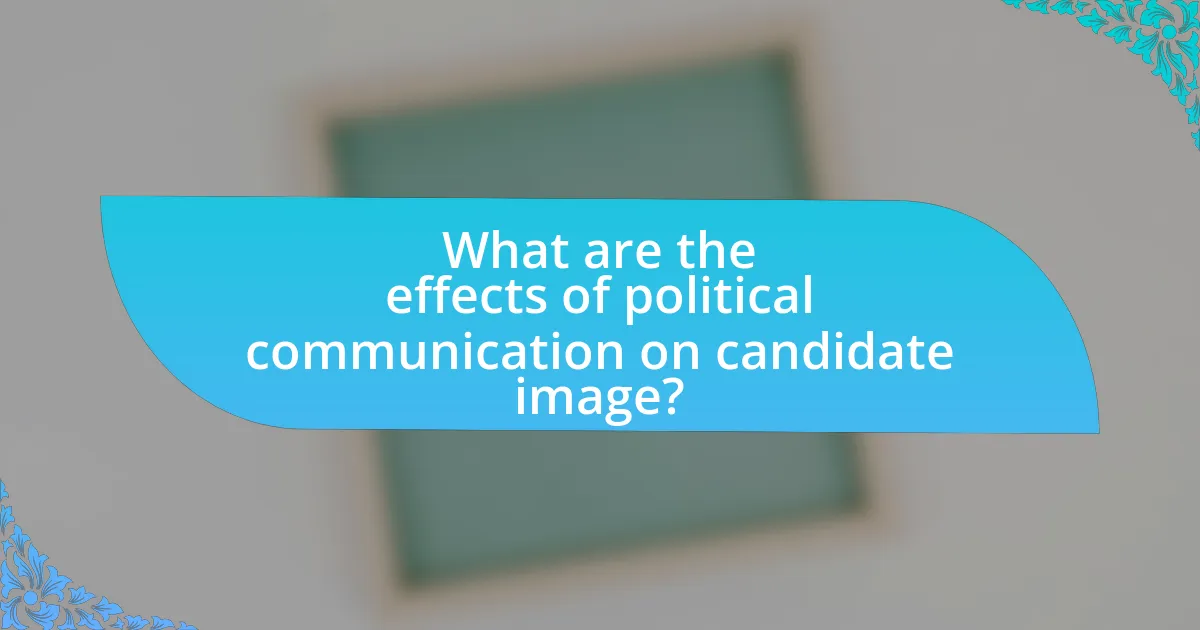
What are the effects of political communication on candidate image?
Political communication significantly shapes candidate image by influencing public perception and voter behavior. Effective messaging, including speeches, advertisements, and social media interactions, can enhance a candidate’s appeal, credibility, and relatability. For instance, research by the Pew Research Center indicates that candidates who engage actively on social media platforms can foster a more positive image, as they appear more accessible and in touch with constituents. Additionally, the framing of issues in political communication can lead to shifts in how candidates are viewed; for example, portraying a candidate as a champion of specific social issues can attract particular voter demographics. Thus, the strategic use of political communication is crucial in constructing and maintaining a favorable candidate image.
How does misinformation impact candidate image?
Misinformation significantly damages a candidate’s image by distorting public perception and undermining trust. When false information circulates, it can lead to negative associations, misinterpretations of a candidate’s policies, and a general erosion of credibility. For instance, a study by the Pew Research Center found that 64% of Americans believe misinformation has a major impact on public opinion, suggesting that candidates can suffer reputational harm due to misleading narratives. This distortion can result in decreased voter support and increased polarization, ultimately affecting election outcomes.
What strategies can candidates employ to counter misinformation?
Candidates can employ fact-checking, proactive communication, and engagement with their audience to counter misinformation. Fact-checking involves verifying claims and providing accurate information through official channels, which helps to establish credibility. Proactive communication includes regularly sharing updates and clarifications on social media and other platforms to preemptively address potential misinformation. Engaging with the audience through Q&A sessions or town halls allows candidates to directly address concerns and dispel false narratives. These strategies are supported by studies showing that transparent communication and direct engagement significantly reduce the spread of misinformation in political contexts.
How does public trust influence the effectiveness of political communication?
Public trust significantly enhances the effectiveness of political communication by fostering credibility and engagement between politicians and constituents. When the public perceives political figures as trustworthy, they are more likely to accept messages, policies, and initiatives presented by those figures. Research indicates that high levels of public trust correlate with increased voter participation and support for political agendas, as seen in studies conducted by the Pew Research Center, which found that trust in government leads to greater civic engagement and compliance with policies. Thus, the presence of public trust not only amplifies the reach of political messages but also strengthens the overall impact of political communication strategies.
What role do endorsements play in shaping candidate image?
Endorsements significantly influence a candidate’s image by enhancing credibility and increasing visibility among voters. When a respected figure or organization endorses a candidate, it signals to the electorate that the candidate is trustworthy and aligns with certain values or policies. For instance, endorsements from prominent political figures or well-known organizations can lead to a measurable increase in a candidate’s approval ratings, as seen in various electoral studies. Research conducted by the Pew Research Center indicates that candidates who receive endorsements from influential figures tend to experience a boost in voter support, demonstrating the power of endorsements in shaping public perception and candidate image.
How do endorsements from influential figures affect voter perception?
Endorsements from influential figures significantly enhance voter perception by increasing credibility and trust in the endorsed candidate. When respected individuals, such as celebrities or political leaders, publicly support a candidate, they can sway undecided voters and reinforce the opinions of supporters. Research indicates that endorsements can lead to a measurable increase in a candidate’s favorability ratings; for instance, a study by the Pew Research Center found that 60% of voters are influenced by endorsements when making their decisions. This effect is particularly pronounced among younger voters who often look to influential figures for guidance in political matters.
What are the risks associated with endorsements in political communication?
Endorsements in political communication carry several risks, including potential alienation of voters, misalignment with candidate values, and backlash from opposing groups. When a prominent figure endorses a candidate, it may alienate certain voter demographics who disagree with the endorser’s views or actions, leading to a loss of support. Additionally, if the endorser’s values do not align with those of the candidate, it can create confusion and distrust among voters, undermining the candidate’s image. Historical examples, such as endorsements that backfired during elections, illustrate how public figures can inadvertently harm a candidate’s campaign. For instance, endorsements from controversial figures can provoke negative media coverage and mobilize opposition, ultimately affecting the candidate’s overall appeal.
How do cultural and social factors influence political communication strategies?
Cultural and social factors significantly influence political communication strategies by shaping the messages, channels, and engagement methods used by political entities. For instance, cultural norms dictate the appropriateness of certain communication styles, such as directness versus indirectness, which can affect how messages are received by different audiences. Social factors, including demographics and community values, determine the relevance of specific issues and the preferred platforms for communication, such as social media or traditional media. Research indicates that political campaigns that align their messaging with the cultural values of their target audience, such as the 2008 Obama campaign utilizing social media to engage younger voters, achieve higher levels of engagement and support. This alignment enhances the effectiveness of political communication strategies by ensuring that they resonate with the audience’s identity and social context.
What demographic considerations must candidates account for in their communication?
Candidates must account for age, gender, ethnicity, socioeconomic status, and education level in their communication. These demographic factors influence how messages are received and interpreted by different audiences. For instance, younger voters may prefer digital communication platforms, while older demographics might respond better to traditional media. Additionally, cultural backgrounds can shape values and priorities, affecting how candidates frame their messages. Research indicates that tailored communication strategies that consider these demographics can enhance engagement and voter support, as evidenced by the 2020 U.S. presidential election, where targeted messaging significantly impacted voter turnout among diverse groups.
How do regional differences affect candidate image building?
Regional differences significantly affect candidate image building by influencing perceptions, values, and priorities of voters. Candidates must tailor their messaging and public persona to resonate with the cultural, economic, and social contexts of different regions. For instance, a candidate emphasizing economic growth may find greater support in industrial regions, while those focusing on environmental issues may appeal more to urban voters concerned about sustainability. Research indicates that candidates who align their platforms with regional concerns, such as the 2020 U.S. presidential election where Joe Biden focused on healthcare in suburban areas, tend to enhance their image and voter appeal. This alignment fosters relatability and trust, crucial elements in political communication and image building.
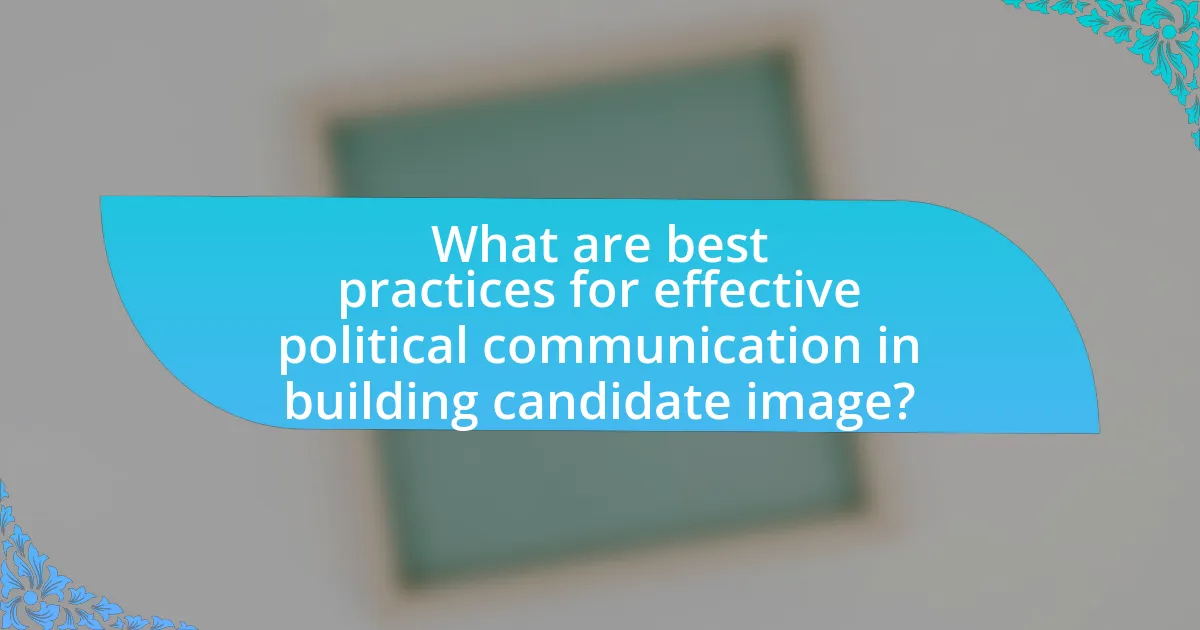
What are best practices for effective political communication in building candidate image?
Effective political communication in building a candidate’s image involves clear messaging, consistent branding, and engaging storytelling. Clear messaging ensures that the candidate’s values and policies are easily understood by the electorate, which is crucial for voter connection. Consistent branding across all platforms reinforces the candidate’s identity, making it easier for voters to recognize and remember them. Engaging storytelling allows candidates to connect emotionally with voters, making their messages more relatable and impactful. Research indicates that candidates who effectively utilize these practices can significantly enhance their public perception and increase voter support. For instance, a study by the Pew Research Center found that candidates who maintain a consistent message across various media platforms are perceived as more trustworthy and competent.
How can candidates effectively engage with their audience?
Candidates can effectively engage with their audience by utilizing targeted messaging and interactive platforms. Targeted messaging involves tailoring communication to address the specific interests and concerns of different demographic groups, which can enhance relatability and connection. For instance, research shows that candidates who adapt their messages based on audience data, such as polling information, can increase voter engagement by up to 30%. Additionally, interactive platforms like social media allow candidates to foster real-time dialogue, enabling them to respond to audience questions and feedback promptly. This two-way communication not only builds trust but also encourages a sense of community among supporters, reinforcing the candidate’s image as approachable and responsive.
What techniques can be used to create authentic connections with voters?
To create authentic connections with voters, candidates can employ techniques such as active listening, personalized communication, and community engagement. Active listening involves genuinely understanding voter concerns and feedback, which fosters trust and rapport. Personalized communication, such as addressing voters by name and tailoring messages to their specific interests, enhances relatability and connection. Community engagement through local events and forums allows candidates to interact directly with constituents, demonstrating commitment and accessibility. Research indicates that candidates who engage in these practices are perceived as more trustworthy and relatable, leading to stronger voter relationships.
How can feedback from constituents be integrated into communication strategies?
Feedback from constituents can be integrated into communication strategies by systematically collecting, analyzing, and applying their input to shape messaging and outreach efforts. This process involves utilizing surveys, town hall meetings, and social media interactions to gather constituents’ opinions and concerns, which can then inform the development of targeted communication campaigns. For instance, a study by the Pew Research Center found that 70% of voters appreciate when candidates address their specific concerns, indicating that responsive communication enhances candidate image and voter engagement. By actively incorporating constituent feedback, political entities can create more relevant and effective communication strategies that resonate with their audience.
What are common pitfalls to avoid in political communication?
Common pitfalls to avoid in political communication include lack of clarity, failure to understand the audience, and inconsistency in messaging. Lack of clarity can lead to misunderstandings and misinterpretations, which can damage a candidate’s image. For instance, ambiguous statements can create confusion about a candidate’s stance on key issues. Failure to understand the audience can result in messages that do not resonate, leading to disengagement. Research shows that tailored communication strategies significantly enhance voter connection. Inconsistency in messaging undermines credibility; when candidates change their positions frequently, it raises doubts about their integrity and reliability. These pitfalls can severely impact a candidate’s ability to build a positive image and connect with voters effectively.
How can candidates ensure consistency in their messaging?
Candidates can ensure consistency in their messaging by developing a clear and coherent communication strategy that aligns with their core values and campaign objectives. This involves creating a messaging framework that outlines key themes, language, and narratives to be used across all platforms and interactions. Research indicates that consistent messaging enhances voter trust and recognition, as seen in studies by the Pew Research Center, which found that voters respond positively to candidates who maintain a unified message throughout their campaigns. By regularly training campaign staff and volunteers on this framework, candidates can further reinforce message consistency, ensuring that all communications reflect the same principles and goals.
What are the consequences of negative campaigning on candidate image?
Negative campaigning significantly damages a candidate’s image by fostering perceptions of untrustworthiness and negativity. Research indicates that candidates who engage in negative campaigning often experience a decline in voter favorability, as voters associate them with dishonesty and aggression. For instance, a study published in the Journal of Politics found that negative ads can lead to a 10-20% decrease in approval ratings for candidates involved in such tactics. Additionally, negative campaigning can polarize the electorate, leading to increased voter apathy and disengagement, which further undermines a candidate’s public perception.
What practical tips can candidates follow to enhance their image through communication?
Candidates can enhance their image through communication by employing clear messaging, active listening, and consistent engagement with their audience. Clear messaging ensures that candidates articulate their policies and values in a straightforward manner, which helps to build trust and credibility. Active listening demonstrates respect for constituents’ opinions and fosters a sense of connection, making voters feel valued. Consistent engagement, whether through social media, town halls, or community events, reinforces a candidate’s presence and commitment to their constituents. Research indicates that candidates who maintain a strong communication strategy are perceived more favorably, as effective communication is linked to higher voter trust and support.












